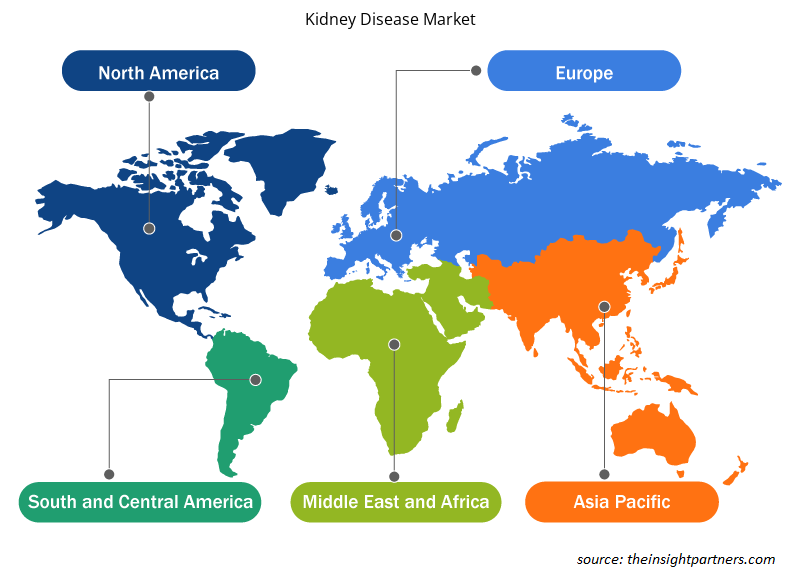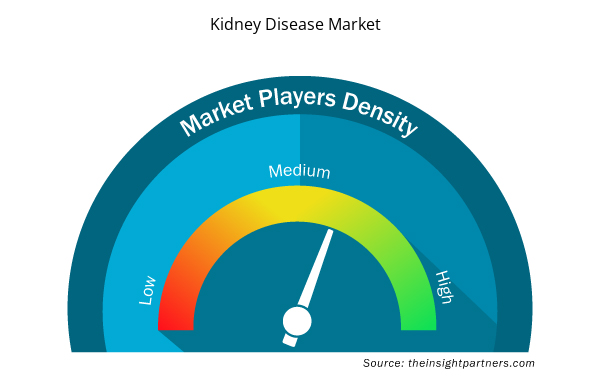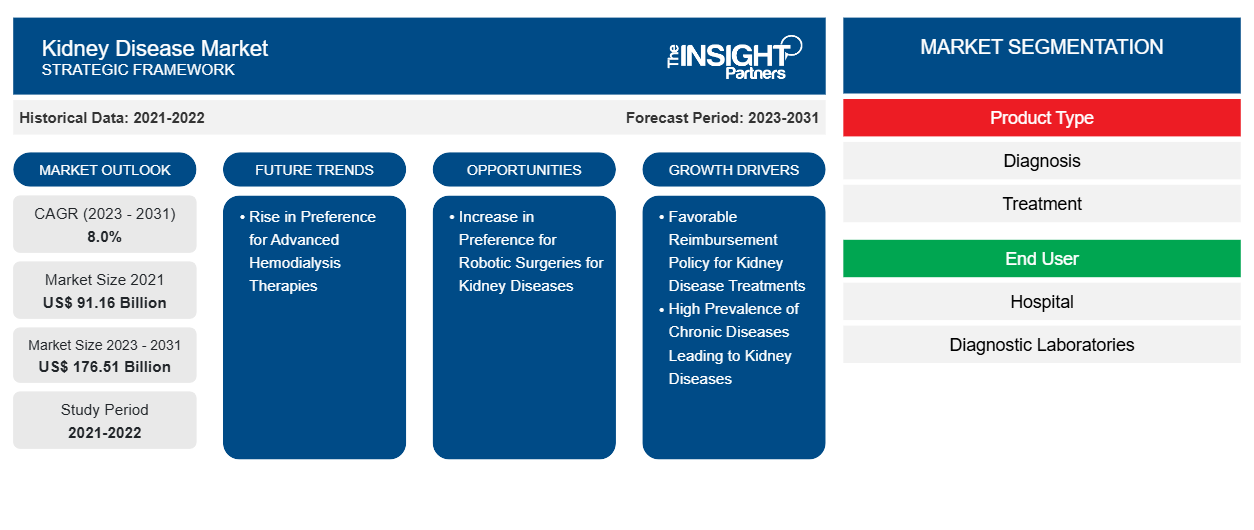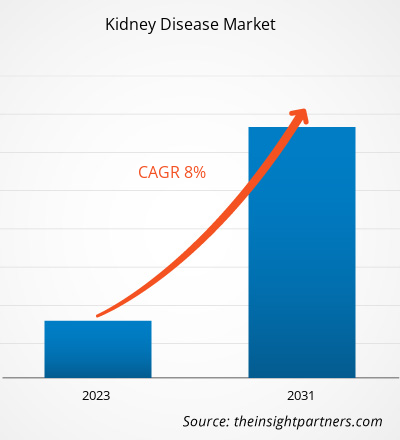Se estimó que el tamaño del mercado de enfermedades renales sería de US$ 91,16 mil millones en 2021 y US$ XX mil millones en 2023 y se espera que alcance los US$ 176,51 mil millones para 2031; se estima que registrará una CAGR del 8,0% en 2023-2031.
La aparición de productos orientados al consumidor y que respetan la seguridad ha estado motivada por la creciente prevalencia de enfermedades renales y por un número cada vez mayor de pacientes geriátricos dispuestos a quedarse en casa para recibir tratamiento. Es probable que estas alternativas terapéuticas avanzadas sigan siendo tendencias clave en el mercado de las enfermedades renales.
Análisis del mercado de enfermedades renales
La enfermedad renal crónica (ERC) es una afección común y potencialmente mortal que afecta a 1 de cada 10 personas en todo el mundo. La hipertensión arterial y la diabetes representan dos tercios de todos los casos de ERC. Además, en 2020, según el estudio publicado por la National Kidney Foundation, aproximadamente el 35% de la población diabética mayor de 20 años desarrollaría enfermedad renal crónica durante el período. Además, la Organización Mundial de la Salud describió varias estrategias para mantener las políticas de los responsables políticos, incluido el concepto de lista de medicamentos vitales y el enfoque de cobertura sanitaria universal (CSU). Además, con el aumento del costo de vida, el reembolso de los servicios públicos es esencial en el tratamiento de diálisis domiciliaria. Los países europeos han desarrollado sistemas de reembolso que pretenden ofrecer varios medicamentos cruciales sin costo o a un costo reducido. Por ejemplo, en febrero de 2024, el gobierno escocés introdujo las primeras pautas nacionales para el reembolso de las personas que se someten a diálisis domiciliaria en Escocia tras la campaña de Kidney Care UK. Además, en Gales, se ofrece reembolso para todas las formas de diálisis domiciliaria. Se espera que estos factores impulsen el crecimiento del mercado durante el período de pronóstico.
Descripción general del mercado de enfermedades renales
En la ERC, los riñones están dañados y no pueden filtrar la sangre, lo que provoca un exceso de líquido y desechos de la sangre en el cuerpo que causan otros problemas de salud, como enfermedades cardíacas y accidentes cerebrovasculares. Los Centros para el Control y la Prevención de Enfermedades (CDC) afirmaron que más de 1 de cada 7 adultos estadounidenses, alrededor de 35,5 millones de personas o el 14%, tienen ERC. 9 de cada 10 adultos desconocen que tienen ERC y 1 de cada 3 adultos con ERC grave no saben que tienen ERC. Otro impulsor importante del mercado es el aumento de la población geriátrica, ya que el envejecimiento es el factor de riesgo para la creciente incidencia de enfermedades renales. Por ejemplo, según un estudio publicado por el Population Reference Bureau (PRB) en 2024, se proyecta que los estadounidenses mayores de 65 años o más aumentarán de 58 millones en 2022 a 82 millones en 2050, un aumento del 47% y la participación de la población total aumentará del 17% al 23%. El apoyo continuo del gobierno de los EE. UU. brindará oportunidades lucrativas en el país. Por ejemplo, en febrero de 2024, Simple HealthKit lanzó un nuevo programa de atención renal para apoyar a los planes de salud. Este programa brinda detección temprana para ayudar a los pacientes a lograr mejores resultados y reducir drásticamente el costo de la atención. Simple HealthKit se asoció con planes de salud comerciales y gubernamentales en sus ofertas existentes y trabaja con ellos para diseñar programas de pruebas personalizados que se puedan implementar para conectarse con miembros a los que es difícil llegar.
Personalice este informe según sus necesidades
Obtendrá personalización en cualquier informe, sin cargo, incluidas partes de este informe o análisis a nivel de país, paquete de datos de Excel, así como también grandes ofertas y descuentos para empresas emergentes y universidades.
- Obtenga las principales tendencias clave del mercado de este informe.Esta muestra GRATUITA incluirá análisis de datos, desde tendencias del mercado hasta estimaciones y pronósticos.
Factores impulsores y oportunidades del mercado de enfermedades renales
Alta prevalencia de enfermedades crónicas que conducen a enfermedades renales favorecen el mercado
La enfermedad renal crónica afecta la función renal y causa daño renal. Las enfermedades y afecciones que causan enfermedad renal crónica incluyen diabetes e hipertensión arterial. Según el informe publicado en la Biblioteca Nacional de Medicina (NLM), alrededor del 80% de la carga mundial de diabetes proviene de países de ingresos bajos y medios, y el 60% de los casos se encuentran en Asia, es decir, 6 de los 10 países con mayor prevalencia de diabetes están en Asia. Según el Foro Económico Mundial, China tiene una de las tasas más altas de diabetes del mundo y sigue empeorando. En China, en 2021, se estima que había 141 millones de diabéticos en el país y se proyecta que su prevalencia en adultos de 20 a 79 años aumentará del 8,2% al 9,7% durante 2020-2030.
Aumento de la preferencia por las cirugías robóticas para enfermedades renales: una oportunidad
Según la National Kidney Foundation Inc., la enfermedad renal conlleva un mayor riesgo de cáncer de riñón y es la segunda causa principal de muerte en pacientes con enfermedad renal crónica (ERC). Para una escisión precisa del tumor, se utiliza el enfoque de nefrectomía parcial robótica para mantener intactas las partes sanas y funcionales del riñón. Además, la nefrectomía parcial robótica FAST es un enfoque mejorado para extirpar quirúrgicamente un tumor renal y reconstruir el riñón para prevenir el daño funcional. La adopción de la robótica en cirugías ha aumentado significativamente en varios países de América del Norte, Europa y Asia.
Análisis de segmentación del informe de mercado de enfermedades renales
Los segmentos clave que contribuyeron a la derivación del análisis del mercado de la enfermedad renal son el tipo de producto y el usuario final.
- Según el tipo de producto, el mercado de enfermedades renales se divide en diagnóstico y tratamiento. El segmento de diagnóstico se subdivide en análisis de sangre, análisis de orina, pruebas de diagnóstico por imagen y otros. El segmento de tratamiento se subdivide a su vez en clase de medicamentos, diálisis y otros. El segmento de diagnóstico tuvo una mayor participación de mercado en 2023.
- Por usuario final, el mercado está segmentado en laboratorios de diagnóstico, hospitales y otros. El segmento de hospitales tuvo la mayor participación del mercado en 2023.
Análisis de la cuota de mercado de la enfermedad renal por geografía
El alcance geográfico del informe de mercado de enfermedades renales se divide principalmente en cinco regiones: América del Norte, Asia Pacífico, Europa, Medio Oriente y África, y América del Sur/América del Sur y Central.
América del Norte ha dominado el mercado de enfermedades renales. En Estados Unidos, alrededor del 15 % de los adultos padecen enfermedad renal crónica. Unos 37 millones de personas en Estados Unidos viven con enfermedad renal crónica. América del Norte tuvo la mayor participación en 2022. Debido a la creciente incidencia de ERC en la región y la presencia de actores del mercado global, son factores que contribuyen al dominio del mercado de enfermedades renales de América del Norte. Se prevé que Asia Pacífico crezca con la CAGR más alta en los próximos años.
Noticias y desarrollos recientes sobre el mercado de enfermedades renales
El mercado de enfermedades renales se evalúa mediante la recopilación de datos cualitativos y cuantitativos posteriores a la investigación primaria y secundaria, que incluye publicaciones corporativas importantes, datos de asociaciones y bases de datos. A continuación, se incluye una lista de los avances en el mercado de enfermedades renales:
- Boehringer Ingelheim y Eli Lilly and Company anunciaron que la Administración de Alimentos y Medicamentos de los Estados Unidos (FDA) aprobó los comprimidos de Jardiance (empagliflozina) de 10 mg para reducir el riesgo de disminución sostenida de la tasa de filtración glomerular estimada (TFGe), enfermedad renal terminal, muerte cardiovascular y hospitalización en adultos con enfermedad renal crónica (ERC) con riesgo de progresión. (Fuente: Boehringer Ingelheim y Eli Lilly and Company/Sitio web de la empresa, septiembre de 2023)
- La Administración de Alimentos y Medicamentos de los Estados Unidos aprobó los comprimidos orales de Farxiga (dapagliflozina) para reducir el riesgo de deterioro de la función renal, insuficiencia renal, muerte cardiovascular y hospitalización por insuficiencia cardíaca en adultos con enfermedad renal crónica que corren el riesgo de progresión de la enfermedad. (Fuente: Administración de Alimentos y Medicamentos de los Estados Unidos, comunicado de prensa, abril de 2021)
Perspectivas regionales del mercado de enfermedades renales
Los analistas de Insight Partners explicaron en detalle las tendencias y los factores regionales que influyen en el mercado de enfermedades renales durante el período de pronóstico. Esta sección también analiza los segmentos y la geografía del mercado de enfermedades renales en América del Norte, Europa, Asia Pacífico, Oriente Medio y África, y América del Sur y Central.

- Obtenga datos regionales específicos para el mercado de enfermedades renales
Alcance del informe de mercado sobre enfermedades renales
| Atributo del informe | Detalles |
|---|---|
| Tamaño del mercado en 2021 | US$ 91,16 mil millones |
| Tamaño del mercado en 2031 | US$ 176,51 mil millones |
| CAGR global (2023 - 2031) | 8.0% |
| Datos históricos | 2021-2022 |
| Período de pronóstico | 2023-2031 |
| Segmentos cubiertos | Por tipo de producto
|
| Regiones y países cubiertos | América del norte
|
| Líderes del mercado y perfiles de empresas clave |
|
Densidad de actores del mercado de enfermedades renales: comprensión de su impacto en la dinámica empresarial
El mercado de enfermedades renales está creciendo rápidamente, impulsado por la creciente demanda de los usuarios finales debido a factores como la evolución de las preferencias de los consumidores, los avances tecnológicos y una mayor conciencia de los beneficios del producto. A medida que aumenta la demanda, las empresas amplían sus ofertas, innovan para satisfacer las necesidades de los consumidores y aprovechan las tendencias emergentes, lo que impulsa aún más el crecimiento del mercado.
La densidad de actores del mercado se refiere a la distribución de las empresas o firmas que operan dentro de un mercado o industria en particular. Indica cuántos competidores (actores del mercado) están presentes en un espacio de mercado determinado en relación con su tamaño o valor total de mercado.
Las principales empresas que operan en el mercado de enfermedades renales son:
- Laboratorios Abbott
- Compañía Inc.
- F. Hoffmann-La Roche Ltd
- GlaxoSmithKline PLC
- Pfizer Inc.
- Ingenieros sanitarios Siemens
Descargo de responsabilidad : Las empresas enumeradas anteriormente no están clasificadas en ningún orden particular.

- Obtenga una descripción general de los principales actores clave del mercado de enfermedades renales
Informe de mercado sobre enfermedades renales: cobertura y resultados
El informe “Tamaño y pronóstico del mercado de enfermedades renales (2022-2030)” proporciona un análisis detallado del mercado que cubre las siguientes áreas:
- Tamaño del mercado y pronóstico a nivel global, regional y nacional para todos los segmentos clave del mercado cubiertos bajo el alcance
- Dinámica del mercado, como impulsores, restricciones y oportunidades clave
- Principales tendencias futuras
- Análisis detallado de las cinco fuerzas de Porter y PEST y FODA
- Análisis del mercado global y regional que cubre las tendencias clave del mercado, los principales actores, las regulaciones y los desarrollos recientes del mercado.
- Análisis del panorama de la industria y de la competencia que abarca la concentración del mercado, el análisis de mapas de calor, los actores destacados y los desarrollos recientes
- Perfiles detallados de empresas
- Análisis histórico (2 años), año base, pronóstico (7 años) con CAGR
- Análisis PEST y FODA
- Tamaño del mercado Valor/volumen: global, regional, nacional
- Industria y panorama competitivo
- Conjunto de datos de Excel


- Terahertz Technology Market
- Trade Promotion Management Software Market
- Malaria Treatment Market
- Rugged Phones Market
- Medical Collagen Market
- Excimer & Femtosecond Ophthalmic Lasers Market
- Biopharmaceutical Contract Manufacturing Market
- Investor ESG Software Market
- Pipe Relining Market
- Medical Enzyme Technology Market

Report Coverage
Revenue forecast, Company Analysis, Industry landscape, Growth factors, and Trends

Segment Covered
This text is related
to segments covered.

Regional Scope
North America, Europe, Asia Pacific, Middle East & Africa, South & Central America

Country Scope
This text is related
to country scope.
Trends and growth analysis reports related to Life Sciences : READ MORE..
- Abbott Laboratories
- Amgen Inc.
- AstraZeneca PLC
- Beckman Coulter
- F. Hoffmann-La Roche Ltd
- GlaxoSmithKline PLC
- Pfizer Inc.
- Siemens Healthineers
- Sysmex Corporation
- Teva Pharmaceutical Industries Ltd.
The Insight Partners performs research in 4 major stages: Data Collection & Secondary Research, Primary Research, Data Analysis and Data Triangulation & Final Review.
- Data Collection and Secondary Research:
As a market research and consulting firm operating from a decade, we have published and advised several client across the globe. First step for any study will start with an assessment of currently available data and insights from existing reports. Further, historical and current market information is collected from Investor Presentations, Annual Reports, SEC Filings, etc., and other information related to company’s performance and market positioning are gathered from Paid Databases (Factiva, Hoovers, and Reuters) and various other publications available in public domain.
Several associations trade associates, technical forums, institutes, societies and organization are accessed to gain technical as well as market related insights through their publications such as research papers, blogs and press releases related to the studies are referred to get cues about the market. Further, white papers, journals, magazines, and other news articles published in last 3 years are scrutinized and analyzed to understand the current market trends.
- Primary Research:
The primarily interview analysis comprise of data obtained from industry participants interview and answers to survey questions gathered by in-house primary team.
For primary research, interviews are conducted with industry experts/CEOs/Marketing Managers/VPs/Subject Matter Experts from both demand and supply side to get a 360-degree view of the market. The primary team conducts several interviews based on the complexity of the markets to understand the various market trends and dynamics which makes research more credible and precise.
A typical research interview fulfils the following functions:
- Provides first-hand information on the market size, market trends, growth trends, competitive landscape, and outlook
- Validates and strengthens in-house secondary research findings
- Develops the analysis team’s expertise and market understanding
Primary research involves email interactions and telephone interviews for each market, category, segment, and sub-segment across geographies. The participants who typically take part in such a process include, but are not limited to:
- Industry participants: VPs, business development managers, market intelligence managers and national sales managers
- Outside experts: Valuation experts, research analysts and key opinion leaders specializing in the electronics and semiconductor industry.
Below is the breakup of our primary respondents by company, designation, and region:

Once we receive the confirmation from primary research sources or primary respondents, we finalize the base year market estimation and forecast the data as per the macroeconomic and microeconomic factors assessed during data collection.
- Data Analysis:
Once data is validated through both secondary as well as primary respondents, we finalize the market estimations by hypothesis formulation and factor analysis at regional and country level.
- Macro-Economic Factor Analysis:
We analyse macroeconomic indicators such the gross domestic product (GDP), increase in the demand for goods and services across industries, technological advancement, regional economic growth, governmental policies, the influence of COVID-19, PEST analysis, and other aspects. This analysis aids in setting benchmarks for various nations/regions and approximating market splits. Additionally, the general trend of the aforementioned components aid in determining the market's development possibilities.
- Country Level Data:
Various factors that are especially aligned to the country are taken into account to determine the market size for a certain area and country, including the presence of vendors, such as headquarters and offices, the country's GDP, demand patterns, and industry growth. To comprehend the market dynamics for the nation, a number of growth variables, inhibitors, application areas, and current market trends are researched. The aforementioned elements aid in determining the country's overall market's growth potential.
- Company Profile:
The “Table of Contents” is formulated by listing and analyzing more than 25 - 30 companies operating in the market ecosystem across geographies. However, we profile only 10 companies as a standard practice in our syndicate reports. These 10 companies comprise leading, emerging, and regional players. Nonetheless, our analysis is not restricted to the 10 listed companies, we also analyze other companies present in the market to develop a holistic view and understand the prevailing trends. The “Company Profiles” section in the report covers key facts, business description, products & services, financial information, SWOT analysis, and key developments. The financial information presented is extracted from the annual reports and official documents of the publicly listed companies. Upon collecting the information for the sections of respective companies, we verify them via various primary sources and then compile the data in respective company profiles. The company level information helps us in deriving the base number as well as in forecasting the market size.
- Developing Base Number:
Aggregation of sales statistics (2020-2022) and macro-economic factor, and other secondary and primary research insights are utilized to arrive at base number and related market shares for 2022. The data gaps are identified in this step and relevant market data is analyzed, collected from paid primary interviews or databases. On finalizing the base year market size, forecasts are developed on the basis of macro-economic, industry and market growth factors and company level analysis.
- Data Triangulation and Final Review:
The market findings and base year market size calculations are validated from supply as well as demand side. Demand side validations are based on macro-economic factor analysis and benchmarks for respective regions and countries. In case of supply side validations, revenues of major companies are estimated (in case not available) based on industry benchmark, approximate number of employees, product portfolio, and primary interviews revenues are gathered. Further revenue from target product/service segment is assessed to avoid overshooting of market statistics. In case of heavy deviations between supply and demand side values, all thes steps are repeated to achieve synchronization.
We follow an iterative model, wherein we share our research findings with Subject Matter Experts (SME’s) and Key Opinion Leaders (KOLs) until consensus view of the market is not formulated – this model negates any drastic deviation in the opinions of experts. Only validated and universally acceptable research findings are quoted in our reports.
We have important check points that we use to validate our research findings – which we call – data triangulation, where we validate the information, we generate from secondary sources with primary interviews and then we re-validate with our internal data bases and Subject matter experts. This comprehensive model enables us to deliver high quality, reliable data in shortest possible time.


 Obtenga una muestra gratuita de este informe
Obtenga una muestra gratuita de este informe